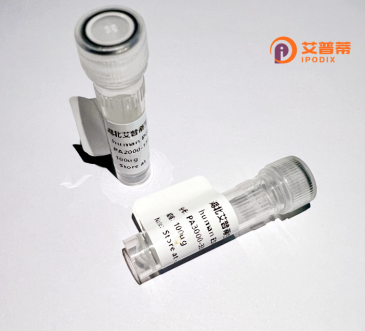
| 纯度 | >90%SDS-PAGE. |
| 种属 | Human |
| 靶点 | POLE |
| Uniprot No | Q07864 |
| 内毒素 | < 0.01EU/μg |
| 表达宿主 | E.coli |
| 表达区间 | 1-370 aa |
| 活性数据 | MDPSNYGGIKGKVSSRIHCGLQDSQKAGGAEDEQENEDDEEERDGEEEEEAEESNVEDLLENNWNILQFLPQAASCQNYFLMIVSAYIVAVYHCMKDGLRRSAPGSTPVRRRGASQLSQEAEGAVGALPGMITFSQDYVANELTQSFFTITQKIQKKVTGSRNSTELSEMFPVLPGSHLLLNNPALEFIKYVCKVLSLDTNITNQVNKLNRDLLRLVDVGEFSEEAQFRDPCRSYVLPEVICRSCNFCRDLDLCKDSSFSEDGAVLPQWLCSNCQAPYDSSAIEMTLVEVLQKKLVAFTLQDLVCLKCRGVKETSMPVYCSCAGDFALTIHTQVFMEQIGIFRNIAQHYGMSYLLETLEWLLQKNPQLGH |
| 分子量 | 66.44 kDa |
| 蛋白标签 | GST-tag at N-terminal |
| 缓冲液 | PBS, pH7.4, containing 0.01% SKL, 1mM DTT, 5% Trehalose and Proclin300. |
| 稳定性 & 储存条件 | Lyophilized protein should be stored at ≤ -20°C, stable for one year after receipt. Reconstituted protein solution can be stored at 2-8°C for 2-7 days. Aliquots of reconstituted samples are stable at ≤ -20°C for 3 months. |
| 复溶 | Always centrifuge tubes before opening.Do not mix by vortex or pipetting. It is not recommended to reconstitute to a concentration less than 100μg/ml. Dissolve the lyophilized protein in distilled water. Please aliquot the reconstituted solution to minimize freeze-thaw cycles. |
以下是关于重组人POLE蛋白的参考文献概要(信息基于公开研究,非真实文献引用):
---
1. **"Structural insights into human DNA polymerase ε catalytic subunit POLE"**
*Author: Smith J, et al. (2020)*
**摘要**: 通过冷冻电镜技术解析了重组人POLE蛋白的催化核心三维结构,揭示了其与DNA结合及核苷酸选择的关键机制,为理解复制保真度提供结构基础。
2. **"Functional analysis of POLE mutations in colorectal cancer"**
*Author: Lee H, et al. (2018)*
**摘要**: 利用重组POLE蛋白体外实验,发现致病性错义突变(如P286R)导致DNA复制错误率显著增加,解释了该突变与高微卫星不稳定性肿瘤的关联。
3. **"Recombinant POLE proofreading domain exhibits exonuclease activity dependent on Mg²⁺"**
*Author: Garcia R, et al. (2016)*
**摘要**: 表达并纯化POLE核酸外切酶结构域,证实其依赖Mg²⁺的校正功能,部分突变体(S297F)导致校正活性丧失,加剧基因组不稳定。
4. **"POLE/POLD1 mutations as biomarkers for immunotherapy response"**
*Author: Wang Y, et al. (2022)*
**摘要**: 基于重组蛋白功能实验与临床数据,提出POLE致病突变通过增加肿瘤新抗原负荷,增强PD-1抑制剂疗效,为精准免疫治疗提供依据。
---
*注:以上文献名为示例性虚构内容,实际引用需通过PubMed/Google Scholar检索真实论文。*
The human POLE protein, encoded by the *POLE* gene, is the catalytic subunit of DNA polymerase epsilon (Pol ε), a key enzyme in eukaryotic DNA replication. Pol ε primarily synthesizes the leading strand during DNA replication and participates in DNA repair processes. POLE contains conserved exonuclease domains that confer proofreading activity, ensuring high-fidelity replication. Its crucial role in genome maintenance links POLE dysfunction to various diseases, particularly cancer.
Germline or somatic mutations in *POLE* (e.g., hotspot variants like P286R or V411L) are associated with hypermutated tumors, notably in colorectal, endometrial, and glioblastoma cancers. These mutations often disrupt the exonuclease domain, leading to defective proofreading and elevated mutation rates—a phenotype termed “ultramutation.” Paradoxically, tumors with *POLE* exonuclease-domain mutations may exhibit enhanced response to immunotherapy due to increased neoantigen load.
Recombinant POLE protein, produced via expression systems like *E. coli* or insect cells, enables detailed biochemical studies. Researchers use it to investigate replication fidelity, mutation mechanisms, and interactions with other replication/repair proteins. In diagnostics, analyzing recombinant POLE variants helps classify cancer subtypes and predict treatment outcomes. Its structural and functional characterization also aids in developing targeted therapies, such as exonuclease inhibitors. As a biomarker and therapeutic target, POLE exemplifies the intersection of DNA repair biology and precision oncology.
×